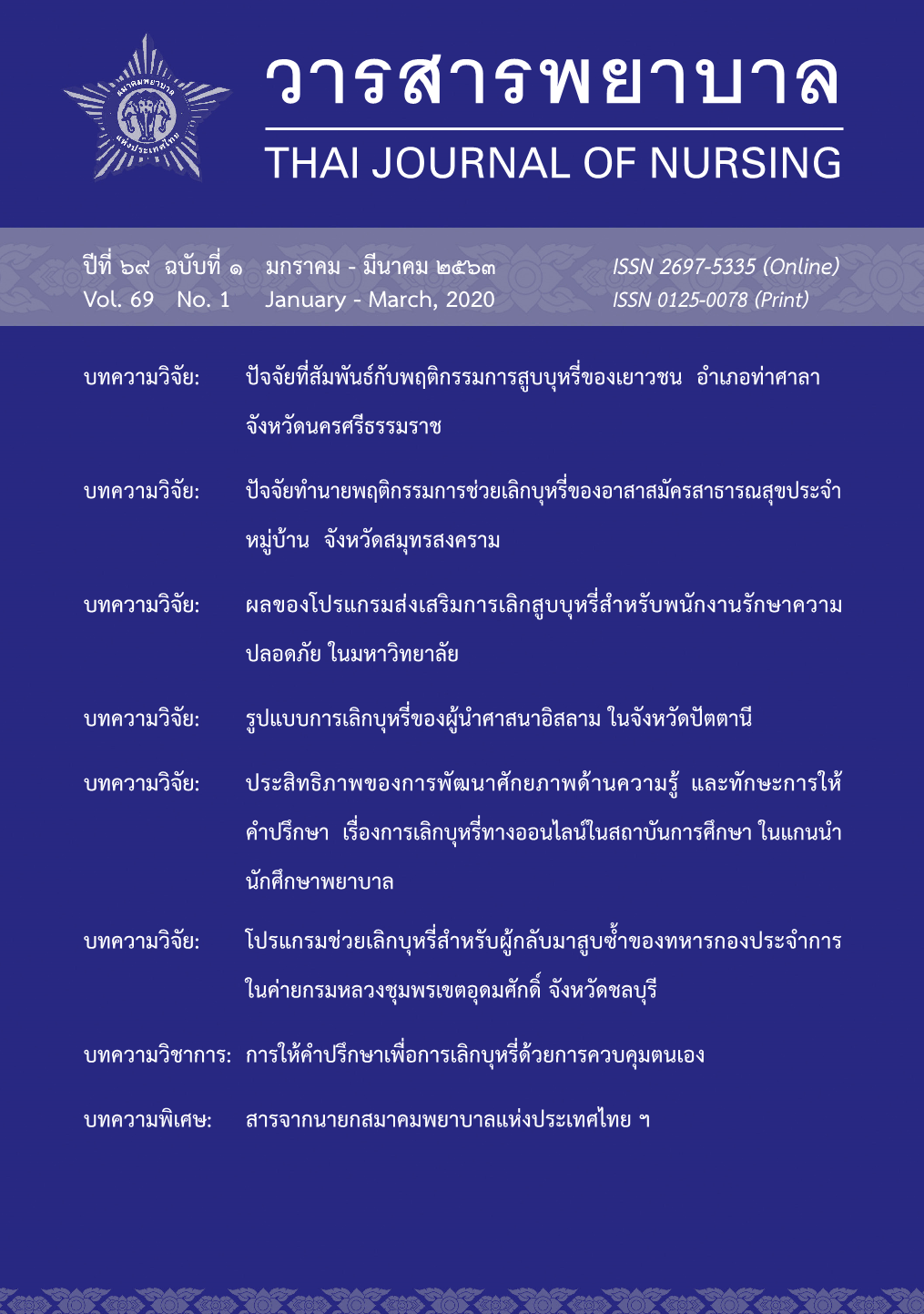Effects of the promoting smoking cessation program among security guards in a university
Main Article Content
Abstract
The purpose of this quasi-experimental research aimed to examine the effects of the promoting smoking cessation program on perceived self-efficacy, outcome expectation to quit smoking, and number of cigarettes smoked per day among security guards in a university. The samples of 22 security guards working at Naresuan University, was purposively selected. The research instruments were the promoting smoking cessation program, questionnaires on personal data and smoking behavior, perceived self-efficacy and outcome expectation to quit smoking. Data were collected before and after implementing the promoting smoking cessation program for 3 weeks. Data were analyzed by descriptive statistics, paired t-test, and Wilcoxon signed-ranks test. The results revealed that after receiving the promoting smoking cessation program, security guards perceived self-efficacy to quit smoking higher than before receiving the promoting smoking cessation program and the number of cigarettes smoked per day lesser than before receiving the promoting smoking cessation program at p < .001. In contrast, the outcome expectation to quit smoking of security guards was not significantly different (p > .05).
Article Details
References
จิดาภา อุดมเมฆ และรุจิรา ดวงสงค์. (2555). ผลของโปรแกรมอดบุหรี่ในผู้ป่วยที่มารับบริการคลินิก
ทันตกรรมโรงพยาบาลทันตกรรม คณะทันตแพทยศาสตร์ มหาวิทยาลัยขอนแก่น. ศรีนครินทร์เวช
สาร. 27(4), 379-385.
นัทธพงค์ ศิริจรรยา, จอมใจ ราชคม, ณศพร ธรรมนิธิศ, ธนัญญา วรรณเรศ, รุ่งนภา สุภายอง, ศุภนิดา
ปั้นน้อย, และวงเดือน สุวรรณคีรี. (2561). พฤติกรรมการสูบบุหรี่ และการติดสารนิโคตินของ
พนักงานรักษาความปลอดภัย. วารสารพยาบาล, 67(1), 19-26.
นิยม จันทร์นวล, และศิริญญา วิลาศรี. (2560). ผลการประยุกต์ทฤษฎีการรับรู้ความสามารถตนเองในการ
ปรับเปลี่ยนพฤติกรรมการสูบบุหรี่ของเจ้าหน้าที่ตำรวจ สถานีตำรวจภูธรเมืองชัยภูมิ. วารสาร
วิทยาลัยพยาบาลบรมราชชนนีนครราชสีมา, 23(1), 44-58.
ปรัชพร กลีบประการเลิกสูบบุหรี่ ต่อพฤติกรรมการเลิกทุม. (2559). ผลของโปรแกรมส่งเสริมสูบบุหรี่
ของผู้สูบบุหรี่ในตำบลบางแก้ว อำเภอเมืองอ่างทอง จังหวัดอ่างทอง (วิทยานิพนธ์ปริญญามหา
บัณฑิต ไม่ได้ตีพิมพ์). มหาวิทยาลัยมหิดล, กรุงเทพมหานคร.
พรรณี ปานเทวัณ. (2560). ทฤษฎีความสามารถของตนเองกับการเลิกสูบบุหรี่. วารสารพยาบาลทหาร
บก, 18(3), 35-41.
ฟอระดี นุชส่งสิน, กรรณิการ์ ฉัตรดอกไม้ไพร, และศิริวรรณ ทิพยรังสฤษฎ์. (2561). มาตรการช่วยเลิก
บุหรีในสถานที่ทำงาน: การทบทวนวรรณกรรม. วารสารวิชาการสาธารณสุข, 27(1), 67-75.
มหาวิทยาลัยมหิดล ศูนย์วิจัยและจัดการความรู้เพื่อการควบคุมยาสูบ. (2561). รายงานสถิติการบริโภค
ยาสูบของประเทศไทย พ.ศ. 2561. กรุงเทพมหานคร: เจริญดีมั่นคงการพิมพ์.
วรัญญา ไชยสาลี. (2559). ผลของโปรแกรมส่งเสริมการเลิกบุหรี่ของผู้ป่วยที่เข้ารับการบำบัดรักษายา
เสพติดในโรงพยาบาลธัญญารักษ์สงขลา จังหวัดสงขลา (วิทยานิพนธ์ปริญญามหาบัณฑิต
ไม่ได้ตีพิมพ์). มหาวิทยาลัยมหิดล, กรุงเทพมหานคร.
Bandura, A. (1986). Social foundations of thought and action: A social cognitive theory
(2nd.ed.). Englewood Cliffs: Prentice-Hall.
Elshatarat, R. A., Yacoub, M. I., Khraim, F. M., Saleh, Z. T., & Afaneh, T. R. (2016). Self-
efficacy in treating tobacco use: A review article. Proceedings of Singapore
Healthcare, 25(4), 243-248.
Lindberg, A., Niska, B., Stridsman, C., Eklund, B., Eriksson, B., & Hedman, L. (2015).
Low nicotine dependence and high self-efficacy can predict smoking cessation
independent of the presence of chronic obstructive pulmonary disease: A three
year follow up of a population-based study. Tobacco Induced Disease, 13(7),
1-8.


